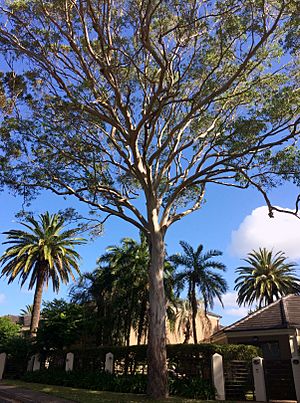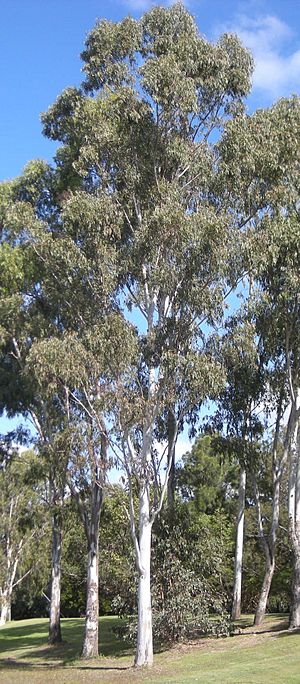Forest red gum facts for kids
Quick facts for kids Forest red gum, blue gum, red irongum |
|
|---|---|
 |
|
| E. tereticornis, Port Hacking NSW | |
| Scientific classification | |
| Genus: |
Eucalyptus
|
| Species: |
tereticornis
|
| Synonyms | |
|
|
The Forest Red Gum (Eucalyptus tereticornis) is a tall tree found in eastern Australia and southern New Guinea. It's also known as the Blue Gum or Red Irongum. This tree is easy to spot because of its smooth bark and its long, curved leaves. It produces white flowers and round, woody fruits.
Contents
What Does It Look Like?
The Forest Red Gum is a big tree, usually growing between 20 m (66 ft) and 50 m (160 ft) tall. That's like a 7 to 17-story building! It has a straight trunk that can be up to 2 m (6 ft 7 in) wide.
Its bark is very smooth. It peels off in patches, showing different colors like white, grey, and blue. This makes the trunk look like it has a cool, patchy design.
Young trees have dull, bluish-green leaves that are egg-shaped. They are about 60 mm (2.4 in) to 130 mm (5.1 in) long. As the tree gets older, its leaves become longer and more pointed, like a spear. These adult leaves are the same green color on both sides.
The tree's flower buds grow in small groups of seven, nine, or eleven. They are shaped like long ovals. When they open, they reveal beautiful white flowers. You can often see these flowers at different times of the year. After the flowers, the tree grows small, woody, round fruits.
Its Name and Family Tree
The scientific name Eucalyptus tereticornis was first given to this tree in 1795 by a scientist named James Edward Smith. He studied samples collected near Port Jackson in Australia.
The name tereticornis comes from two Latin words: teres, meaning "round" or "smooth," and cornu, meaning "horn." This refers to the horn-shaped cap on the flower buds.
Scientists have also found different types, or "subspecies," of the Forest Red Gum. These subspecies are slightly different from each other, often in their leaves or flower parts. Here are the four main subspecies:
- Eucalyptus tereticornis subsp. basaltica: This one has dull, bluish, egg-shaped young leaves.
- Eucalyptus tereticornis subsp. mediana: Its young leaves are also dull and bluish, similar to basaltica.
- Eucalyptus tereticornis subsp. rotunda: This subspecies has green, round young leaves.
- Eucalyptus tereticornis subsp. tereticornis: This is the most common type. Its young leaves are more spear-shaped or egg-shaped.
Where Does It Grow?
The Forest Red Gum grows in a very wide area. You can find it from southern Papua New Guinea all the way down to southeastern Victoria in Australia. This means it grows across many different climates!
It's a very important tree in places like the Cumberland Plain Woodlands in Australia. These woodlands are special habitats that need protection.
Each subspecies grows in slightly different places:
- Subspecies basaltica is found in eucalypt woodlands from Kroombit Tops to near Sydney.
- Subspecies mediana grows only in eastern Victoria, often near rivers and wetlands.
- Subspecies rotunda is found in a small area near Mitchell in Queensland, usually along creek banks.
- Subspecies tereticornis is the most widespread. It grows in open forests from the Cape York Peninsula in Queensland, down to southern New South Wales, and even inland to Roma. It's also found in parts of Papua New Guinea.
How People Use It
The wood of the Forest Red Gum is very strong and tough. It's also quite heavy. Because of its strength, it's used for big construction projects, like making railway sleepers (the wooden beams that support train tracks).
The leaves of the Forest Red Gum are also useful. They are used to make a type of eucalyptus oil. This oil often contains something called cineole, which is used in some medicines and cleaning products.
Gallery
- Features of the forest red gum (Eucalyptus tereticornis)
See also
 In Spanish: Eucalyptus tereticornis para niños
In Spanish: Eucalyptus tereticornis para niños









